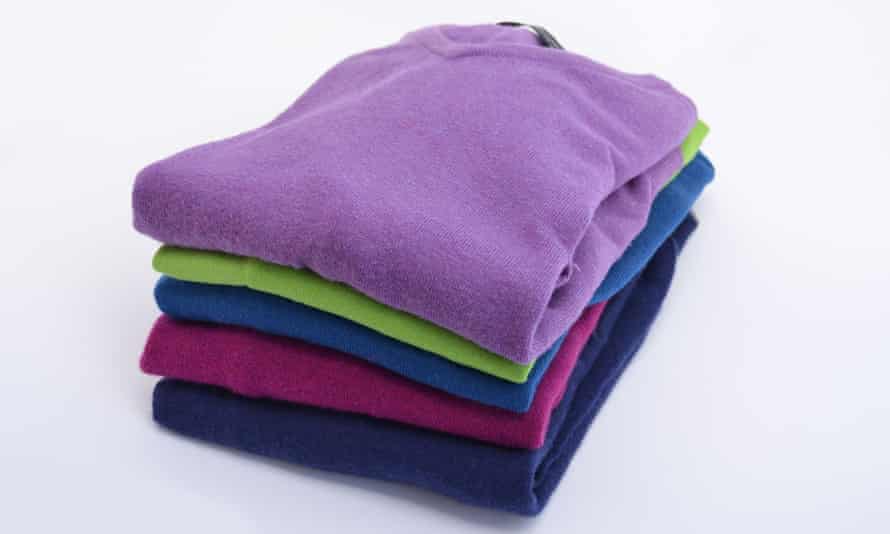
Cashmere is one of the only things about winter I like. I will always take sunshine, heat and slow afternoons over brisk mornings and dark skies.
But, from a charcoal turtleneck I’ve worn so much one of the elbows is wearing thin, to a cream scarf that is still beautiful despite a few moth holes, my favourite cashmere garments make winter more bearable.
Here, some experts explain how to ensure your favourite cashmere pieces last a long time.
Washing cashmere
Like merino wool or other animal hair fibres, cashmere has a waxy coating, so it doesn’t need to be laundered frequently. It should also never be washed using hot water or in the washing machine as both can cause it to shrink.
Mary Poulakis, the managing director of Harrolds, says “traditionally, cashmere should be very carefully hand-washed”. She recommends doing this by filling the laundry sink with lukewarm water, mixing in some baby shampoo or specific cashmere wash and submerging the garment in the water. Next, she says to swish the garment around then drain the sink, fill it with more tepid water and repeat the process without the detergent.
Your next step is to remove as much excess water from the cashmere as possible without damaging the fibres. George McNeil, the managing director of Johnstons of Elgin retail division, says “you should avoid lifting cashmere knitwear while it is saturated with excess water to prevent misshaping”. Instead, he says to squeeze the water gently through the fabric without rubbing, wringing or stretching the garment.
Drying cashmere
Next, McNeil says you can use a short, light washing machine spin cycle to remove any more excess water. But approach doing so with caution as too much agitation can cause a reaction in cashmere fibres that can result in shrinkage.
Then Poulakis says to place the jumper on a flat towel and roll it up slowly. Place pressure on the towel as you go to draw out more excess moisture. Then lay the garment flat on a dry towel somewhere outside in the shade. She says, “Be gentle! Avoid being too rough or wringing out the garment, as you may alter its natural shape.”
When to dry-clean cashmere
Pay attention to care labels, as some cashmere garments should only be dry-cleaned. According to McNeil, this includes woven cashmere products like scarves, stoles, coats and jackets.
He says, “the letter ‘P’ or ‘F’ in a circle on a care label indicates a garment should be dry cleaned”. But since “P” means the product can be dry-cleaned using any solvent, including Perc which can be hazardous, he recommends asking for the “F” method when sending items to be dry-cleaned.
How to handle pilling
McNeil says, “After wearing your cashmere the first few times, you may find small balls of fibre or ‘pills’ forming on the surface. These pills are the result of loose fibres tangling together as areas of your garment rub during wear.”
The design team at Scanlan and Theodore say pills can easily be removed with a de-pill comb or fabric shaver. They recommend “gentle, regular de-pilling once every three weeks to preserve the longevity of your cashmere piece”.
Poulakis advises doing this by lying the garment flat and brushing gently in one direction, using use a cashmere comb or garment bristle brush. “Taking the time to complete this process is so worthwhile – your garment should look as new as the day you bought it,” she says.
Storing cashmere

According to Scanlan and Theodore’s design team, hanging knitwear garments can result in stretching, so knitted cashmere should always be stored folded. They also recommend storing garments with cedar balls as they are a natural repellent for moths that can be drawn to protein fibres and cause holes.
Other ways to keep your cashmere fresh
McNeil says a “great tip to keep your cashmere fresh between washes is to carefully shake woven cashmere clothing and accessories to help remove dust particles.” Fresh air can also lift dirt and dust particles from cashmere fibres. He says, “Hang your garment somewhere the air naturally circulates.”
Ways to make sure your cashmere is sustainable
Cashmere should last for a long time, but wear and tear is inevitable. McNeil says moth holes can be repaired invisibly by professional menders or bigger holes can be repaired with a cashmere patch.
If your garment is beyond repair, he suggests seeking out a circular solution. Johnston’s of Elgin work with a mindful repair and recycling service called Cashmere Circle that can turn a weathered jumper into fingerless gloves or baby clothes like booties or hats.
Standards and certifications
Recently, the cashmere industry has come under fire for over-production resulting in degraded rangelands in China and Mongolia where most of the world’s cashmere is produced. To be sure you are purchasing cashmere that has been farmed sustainably, Scanlan and Theodore’s product team says to look for certifications like The Good Cashmere Standard and the Sustainable Fibre Alliance.


